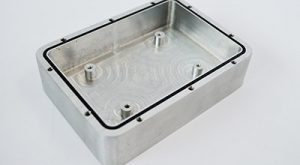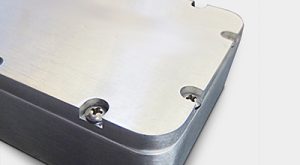
How to design enclosures that protect against water & debris
By Christa Carey, engineering & design services manager, Protocase Inc.
Electronics Engineering custom custom enclosure enclosureQuite often at Protocase, we are asked about custom enclosures that can withstand environmental hazards. This inevitably brings up the issue of NEMA or IP standards, but sometimes there is confusion as to how these work. I’m writing this to give some direction to designers who are tackling this subject. For simplicity’s sake, I’m going to limit myself to NEMA, but the principles are exactly the same if you use IP, so this should still be relevant to you. 
Before starting, you must clearly consider what you are trying to achieve. Are you simply aiming for environmental protection? Or are you trying to meet a formal requirement to achieve a NEMA standard (which may have been imposed by a customer or manager)? Once you have answered these questions, you can determine your best path forward for designing an enclosure that meets your needs.
Understanding NEMA Classification
NEMA standards specify how an enclosure must perform to meet its designated classification. Specifically, NEMA standards deal with the following:
- Protecting personnel from hazardous internal parts
- Protecting equipment inside the enclosure against environmental hazards
The NEMA website, particularly its Standards section, is a helpful resource. This PDF (link: https://www.nema.org/Products/Documents/nema-enclosure-types.pdf#search=types) provides with a breakdown of enclosure types by standard and their specified use.
What NEMA does not do, however, is prescribe how to design and manufacture an enclosure to meet said performance specifications.
How to Meet NEMA requirements
- Sheet metal enclosures (link: https://www.protocase.com/products/electronic-enclosures?utm_source=whitepaper&utm_medium=EPT&utm_campaign=NEMA)
This type of enclosure is very capable of protecting against dust, debris, and splashing or dripping water. Sheet metal enclosures can be designed to meet the requirements of NEMA Types 1, 2, 4, 4X and 5. However, if your enclosure requires immersion in water, this is not the best choice for you. Here are some guidelines:
- NEMA Type 1: We recommend a simple two-piece enclosure style that is fully covered on the top of the case. (L-shape, U-Shape or Extruded Enclosure would work).
- NEMA Type 2: We recommend overlapping flanges on all open seams of the case, using tack, spot or plug welds to fasten the seams. Depending on the severity of the environment, you may require fully welded seams. A U-Shape enclosure would work best, as there are fewer seams to weld.
- NEMA Type 4,4X: We recommend fully welded seams and the use of gaskets. Gaskets are recommended for anything with water being near or directed at this case. In most applications of this category of enclosure gasket, style foam strips or a full gasket piece will suffice. Fastener sealing is required as soon as you bring water into the equation, so we recommend sealing the fasteners. Fastener sealing can be done in many ways including:
- Strategic placement of fasteners so they do not protrude inside the case.
- Assembling with sealing screws.
- Using a latch, lock or hinge to fasten the enclosure closed.

To achieve Type 4X, choose a corrosion-resistant material such as stainless steel, aluminum or galvanneal, and follow the recommendations above.
- NEMA Type 5: We recommend overlapping flanges on all open seams of the case or fully welded seams, depending on the environment. Again, the U-shape enclosure would work best for this design.
- Custom CNC machined enclosure (link: https://www.protocase.com/products/electronic-enclosures/machined.php?utm_source=whitepaper&utm_medium=EPT&utm_campaign=NEMA)
If you’re looking for an enclosure that can be immersed in water, this is it. Machined enclosures can be designed to meet NEMA Types 1, 2, 4(X) and 5. It can also be completely sealed, and with the proper O-rings or gaskets, made waterproof, sufficient to protect against deep liquid immersion and thereby meeting NEMA Type 6(P).
Keep the following in mind when designing this type of enclosure for water immersion:
- The enclosure should be designed in a way to minimize the number of seams to seal, with fewer parts and seams; there is less chance of water entering the enclosure.
- Aluminum is by far the best option. It is possible to work with stainless steel, but the machining cost would be much higher. Other options are not sufficiently corrosion resistant.
- If incorporating an O-ring into the design, keep the O-ring toward the inside of the holes used to assemble the enclosure, in order to prevent leakage through fasteners.
- For final assembly, applying even torque to screws to ensure an even O-ring compression is recommended. The screw size for assembling should increase as the enclosure gets larger.
- Note: Consider screw spacing when designing your enclosure. If screws are too far apart, the seal may be affected, thus compromising the effectiveness of your enclosure’s ability to be watertight.
- Off the Shelf (OTS) Cast Enclosures with CNC machined customizations
At Protocase, we have the ability to special-order off the shelf (OTS) cast enclosures that can be customized. These off-the-shelf enclosures can be watertight with the proper designing and seals, and are very similar to our custom CNC machined enclosures (although not customizable by dimension, as they are not custom-manufactured at Protocase). With minimal customizations or cutouts, along with the proper gaskets or O-rings, this enclosure type could meet NEMA Type 6(P). This type of enclosure will also meet NEMA Types 1, 2, 4(X) and 5 easily.
With this enclosure, as with custom machined enclosures, if you wish to achieve water tightness, you must ensure that every item that penetrates the enclosure (connectors, switches, etc.) are suitably watertight, and equipped with a gasket or sealed as necessary.
NEMA Testing Requirements
Customers will often use NEMA standards to explain what they need their enclosure to do, such as offer a certain resistance to dust, dirt or water, but the enclosures themselves do not need to formally meet NEMA’s standards. If you need to meet a formal NEMA requirement, testing may be required. Protocase does not offer testing of enclosures to verify NEMA requirements, but you can certainly send your enclosures to a third-party testing facility in order to receive formal certification that they have met requirements.
If you have questions NEMA or enclosures that can withstand certain environmental hazards, we’d be happy to help. Email your questions or design requirements to info@protocase.com.
